32 Employee Feedback Examples for Any Situation
Feedback doesn’t have the best reputation. It’s awkward and challenging, and just the thought of it can leave you and your employees tense.
But employee feedback, both positive and constructive, plays a critical role in understanding employee wellbeing, resiliency, and engagement.
Employee feedback has taken on heightened importance as how we work has continued to evolve.
During crises – and now with hybrid or remote work environments more common than ever – clear communications and expectations make a big difference in business outcomes. Both are achievable in a feedback culture that encourages positive employee feedback and healthy, constructive criticism.
In a series of employee surveys, Gallup foundOpens in a new tab that planned feedback signals to employees that their opinions are valued and that you, as an organization, are willing to listen.
Employees who say their manager listens to their work-related problems are 62% less likely to experience burnout, according to Gallup’s employee retention and attraction indicatorsOpens in a new tab. With a decrease in employee burnout comes an increase in employee engagement, productivity, and overall morale.
Of course, it’s also important to note that listening is just the start. For meaningful feedback to sustain itself, it needs to be acted on.
Employees have an inside perspective that enables them to spot issues that might not be immediately evident to leadership.
When employees feel comfortable voicing their concerns, you can catch and correct minor issues before they become more significant.
In this piece, we’re breaking down every element of employee feedback. With a comprehensive understanding of what it is and what it does, you can craft your own feedback strategy that sets your company up for success.

The importance of employee feedback
Employee feedback has a holistic impact on any company. Providing positive feedback communicates that you are taking notice when employees do a good job. It helps employees improve their performance and strengthen relationships with managers, subordinates, and peers. Regular feedback not only empowers individual team members but also the entire company.
Employees are less likely to leave a workplaceOpens in a new tab where leadership values their opinions and ideas. When team members are comfortable with making their voices heard, they experience less stress and are more productive.
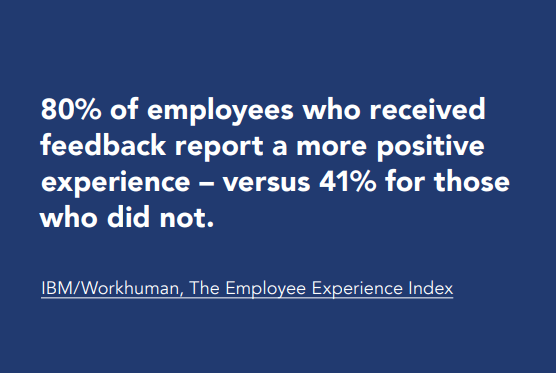
Feedback helps companies adapt to cultural changes and understand the workforce’s morale. It also helps leadership identify areas where team members might need more training.
Start by asking your employees for feedback. By asking managers to give and receive feedback, you establish an atmosphere of openness – an atmosphere that hopefully leads to trust. On a companywide scale, the feedback channel shows everyone that all perspectives and ideas are welcome.
These feedback examples will strengthen their sense of belonging, employee empowerment, and employee engagement.
34 employee feedback examples
There are several types of employee feedback that leadership can give and receive. The following examples illustrate what kinds of feedback work best in different situations.
Positive employee feedback examples
1. Recognition of a skill set
“You always have such creative ideas during our meetings and brainstorming sessions. I appreciate your input.”
Recognizing an employee’s specific skill set lets them know that you value their talent and is more impactful than just saying “good work.”
Giving positive feedback with specificity, especially around an employee’s good qualities like their communication skills, can positively redirect people toward their strengths and help them find new opportunities.
2. Acknowledging achievements outside the workplace
“I really admire you for volunteering at the animal shelter on weekends. It’s nice to know that someone cares about animals in need.”
You shouldn’t restrict positive feedback to what happens in the workplace. Positive behavior deserves some recognition wherever it happens.
Acknowledging a part of their life, like their community engagement or a major life event, shows you value them as a person.
3. Appreciation of hard work
“I appreciate all the extra hours you put into completing this project. Your efforts are why we can deliver this assignment on time.”
This is one of the top-tier positive feedback examples because surveys show that 92% of employeesOpens in a new tab who receive praise for their efforts are more likely to repeat those positive actions.
Recognition is a coaching tool. If you want to see more good work, use feedback conversations to highlight the good.
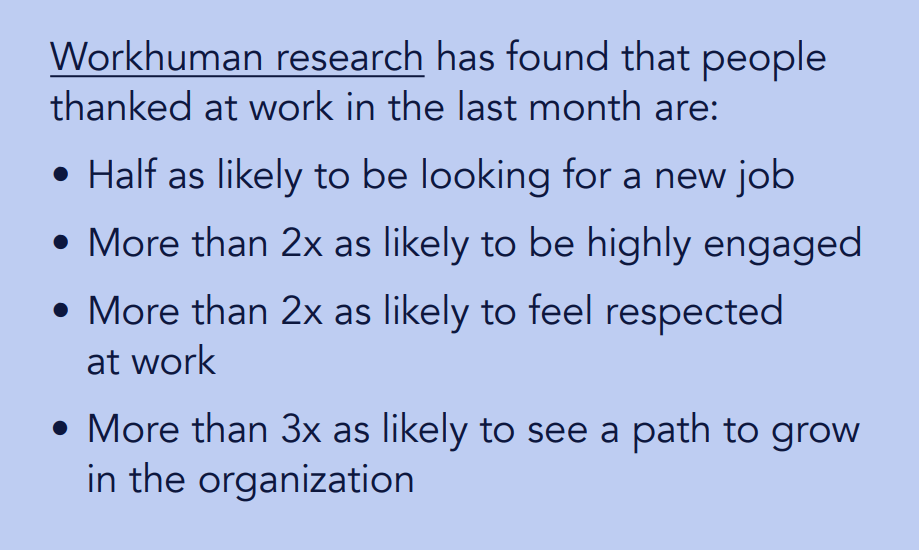
Learn how you can help your company build a positive feedback culture and improve the employee experience!
4. Recognition for being a team player
"I appreciate how you get along with your peers and subordinates in the office. Your strong communication and listening skills can make everyone feel seen and heard."
Feedback does not have to be only about work outcomes. Give spontaneous and real-time feedback on things you appreciate, such as an employee's ability to connect with others at work.
5. Acknowledging leadership skills
"Your leadership skills have resulted in greater bonding among team members and are the reason for us delivering high-quality work. Kudos!"
6. Appreciation for personal development
"Congratulations on achieving this milestone in a short amount of time. You did an amazing job by learning the skills necessary for the project."
Have a culture of feedback that notices and appreciates personal and professional development. This could include learning a new technical or behavioral skill that helped in improving the performance of the person or the team.

Constructive employee feedback examples
It’s worth noting that we shouldn’t consider all constructive feedback as negative feedback. Effective employee feedback relies on both parties to navigate a potentially difficult feedback conversation with openness and respect.
It’s one of the many reasons why it is so important to prioritize frequent positive feedback because it can help create a constructive atmosphere from the start.
1. Talking over others
“I really appreciated your enthusiasm in today’s meeting. However, I noticed that you spoke over some other team members in your excitement. Your input is always welcome, but we also need to hear from others. What do you think?”
It’s easy for some employees to get excited about a project and interrupt their colleagues, even if it isn’t on purpose. Appealing to a team member’s enthusiasm is a positive way to address the issue.
2. Behind schedule
“Thanks for letting me know you’re behind schedule on this assignment. Let’s look at how you spend your time and see if there’s a way to tackle tasks more efficiently.”
Missing deadlines can affect teams, departments, and the entire company. Addressing the issue constructively lets your team members know it’s OK to come to you when they’re struggling with a project, and more easily helps you pinpoint problems that may be impacting employees.
3. A drop in productivity
“I wanted to check in and see how you’re doing. You seem a little distracted lately, and I’d love to know if there’s anything I can do to help. Let’s set up a time to talk. We can review your goals and figure out how to get back on track.”
Even the best employees can experience a drop in productivity due to personal issues or problems in the workplace. Constructive feedback is an important note to strike here because it lets them know that you care and want to see them succeed. Negative feedback could exacerbate the problem.
4. Feedback on time management
"You have generally been on time with your work, which is great. However, there have been some recent delays in meeting delivery deadlines. If you're encountering challenges with managing time or balancing tasks, I’m happy to help you identify solutions and strategies to improve."
Tips for providing feedback:
When addressing poor time management, keep the tone constructive and supportive. If you notice the employee spending excessive time on non-work-related tasks, start a conversation to understand the underlying issues and collaboratively explore solutions.
Creating a feedback culture focused on support and growth ensures employees feel valued, even when their performance needs improvement. It’s also an opportunity to ask for their feedback to uncover potential team-wide issues or adjustments that could improve overall efficiency.
5. Feedback on communication skills
"I’ve noticed some communication challenges recently, and it seems to be affecting our workflow. Is there something you’re dealing with that we can address together to improve this?"
Tips for providing feedback:
Effective communication is essential for teamwork, collaboration, and achieving results. Breakdowns in communication often stem from personal or professional challenges, misunderstandings, or unresolved issues.
As a manager, prioritizing open and constructive dialogue when providing feedback helps identify and resolve communication barriers. By fostering a supportive environment, you encourage employees to share concerns and work collaboratively toward solutions.
6. Feedback on taking initiative
"You are a valuable team member, and your opinions matter to the success of our projects. However, I’ve noticed that you don’t often share your views in meetings. I encourage you to contribute your ideas, even if you’re unsure how they’ll be received—they might spark valuable discussions or lead to great solutions."
Tips for Providing Feedback:
Employees may hold back in meetings due to fear of judgment or rejection. When addressing a lack of initiative, focus on constructive and encouraging feedback that builds confidence and fosters a judgment-free environment.
It’s also important to explore underlying reasons, such as dissatisfaction with work or policies, that might be affecting their engagement. Create a safe space for open dialogue and a feedback loop to understand their perspective and support their growth.
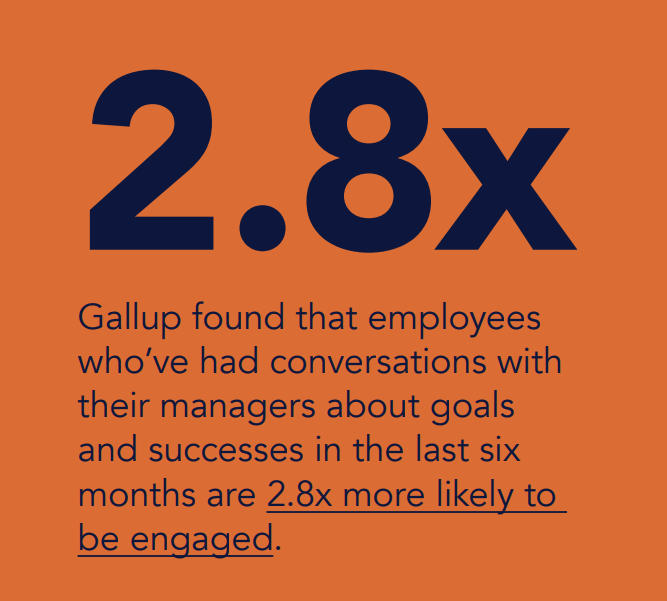
7. Feedback on delegating work
"I truly appreciate your enthusiasm and dedication to your work. However, effective delegation is essential for managing your time and improving the team's overall efficiency. Is there anything I can do to support you in developing this skill?"
Tips for Providing Feedback:
Encourage employees to provide clear instructions when delegating tasks to avoid misunderstandings and delays. Delegation not only helps distribute workloads effectively but also empowers team members to make independent decisions and feel more engaged in their roles.
By emphasizing the value of delegation, you can help employees recognize its benefits for both their personal development and the team's success.
8. Feedback on adjusting to change
"Your adaptability at work is one of your strengths, and I value that. However, I’ve noticed you seem to be facing challenges with the recent changes in the team and systems. Is there anything I can do to support you during this transition?"
Tips for Providing Feedback:
Adjusting to changes—whether in team structure, processes, systems, management, or compensation—can be challenging for employees. While some may not openly express discomfort, it often manifests in their performance.
Approach these situations with constructive feedback in a safe and supportive environment. Encourage open dialogue to understand their concerns and provide guidance to help them navigate the changes effectively. This approach not only resolves immediate challenges but also builds resilience for future transitions.
9. Feedback on creativity at work
"Your work is consistently of high quality, which is fantastic. To elevate it further, consider seeking feedback from peers to explore new ways to introduce creativity. This could help you develop an innovative edge that sets you apart."
Tips for Providing Feedback:
Employees can sometimes become comfortable with established methods, overlooking opportunities for creativity. Encouraging innovation and a feedback-driven approach can help them take their performance to the next level.
Creativity can manifest in various ways—such as proposing unique solutions to project challenges or finding more efficient ways to manage time and resources. By fostering a culture of experimentation and collaboration, you can inspire employees to think outside the box and achieve even greater success.
10. Feedback on conflict resolution
"You demonstrate professionalism when resolving conflicts, which is commendable. However, it’s important to focus solely on the issue at hand and avoid making personal comments during discussions."
Tips for Providing Feedback:
Conflicts can evoke strong emotions such as ego, fear, anger, or even revenge—all of which can harm a healthy workplace environment. Addressing these situations requires tact and support.
Encourage employees to seek guidance or mentoring if they struggle with conflict resolution. Foster a culture of continuous learning where team members feel comfortable seeking advice from colleagues or managers. This not only enhances their skills but also promotes a collaborative and respectful workplace.
11. Feedback on professional development challenges
"You bring great value to our projects, and your contributions are always appreciated. However, I’ve noticed that you sometimes fall into a comfort zone, which may be limiting your potential for professional growth. Would you be open to some suggestions that could help you take the next step?"
Tips for Providing Feedback:
Encourage employees to take a proactive approach to their development by seeking out new challenges, opportunities, and training without waiting for managers to assign them.
Slipping into a comfort zone is a common occurrence and not a fault. Use constructive feedback as a way to gently guide employees toward growth, focusing on their strengths and potential. A supportive and collaborative approach fosters both confidence and motivation for professional advancement.
12. Feedback on team collaboration:
"You have immense potential, and tapping into the strength of your team can amplify it even further. Don’t hesitate to ask for help from your peers—it’s an opportunity for mutual growth and learning."
Tips for Providing Feedback:
Effective team collaboration involves both seeking and offering support, as well as engaging in cross-functional projects to share expertise. Encouraging collaboration can unlock untapped potential in employees and broaden their impact.
When providing feedback, emphasize the value of teamwork in fostering both individual and collective growth. A collaborative approach not only enhances performance but also builds stronger relationships within the team.
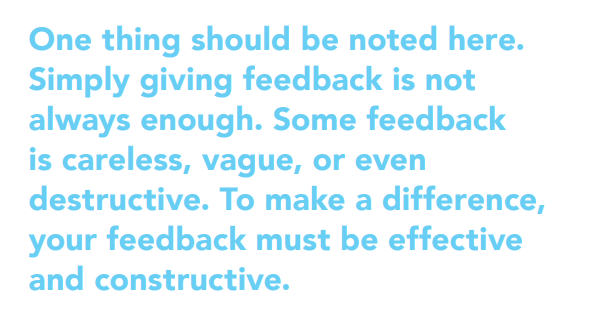
Employee improvement feedback examples
1. Feedback on punctuality
"I’ve noticed that you’ve been late to work several times this week and missed yesterday’s meeting. Let’s review what you missed so we can get you up to speed. If there’s something affecting your ability to arrive on time, I’d like to understand so we can create a plan to ensure you don’t miss future meetings."
Tips for Providing Feedback:
When addressing tardiness, balance empathy with clarity about the impact on the team. Circumstances beyond an employee's control may contribute to lateness, so approach the conversation with an open mind and a willingness to listen.
At the same time, help them understand how consistent tardiness can disrupt workflows and affect their peers. By fostering a supportive environment and working together on solutions, you can address the issue constructively while maintaining morale.
2. Feedback on meeting participation
"I’ve noticed that you haven’t been speaking up during our meetings, and I want to assure you that your insights are highly valued. Hearing from everyone helps us make more well-rounded decisions, so I’d love to have your input at our next meeting. Is there anything I can do to help you feel more comfortable contributing?"
Tips for Providing Feedback:
There are many reasons an employee might hesitate to participate in meetings, such as cultural norms, shyness, or uncertainty about their ideas. Address the issue in a supportive and friendly manner, emphasizing the value of their perspective.
Creating an inclusive environment where all team members feel welcome to share their thoughts can unlock valuable contributions. Encouraging participation through one-on-one conversations or smaller discussions can also help build their confidence.
3. Feedback on toxic behavior
"I’ve observed some interactions where you’ve been sarcastic or displayed behaviors like eye-rolling when engaging with team members. I wanted to check in to see if something is bothering you or if there’s anything I can do to help you feel more positive about being here."
Tips for Providing Feedback:
Toxic behaviors can significantly impact team morale, but the employee may not even realize how their actions come across. Approach the conversation with curiosity and empathy, aiming to uncover any underlying issues.
This could reveal workplace challenges that need addressing or personal difficulties that require flexibility or support. Maintaining a calm and constructive tone helps to de-escalate potential defensiveness and keeps the focus on resolving the issue collaboratively.
Employee performance feedback examples
1. Exceptional performance
"Your performance has been outstanding, and I want to take a moment to acknowledge your hard work and dedication. Your ability to consistently exceed expectations, meet tight deadlines, and deliver exceptional results has been noticed by both your peers and leadership. For example, your innovative approach to [specific project or task] not only solved the immediate problem but also set a new benchmark for excellence."
Tips:
- Be specific about their accomplishments.
- Highlight how their contributions benefit the team or organization.
- Encourage them to take on new challenges to continue their growth.
2. Poor performance
"I’ve noticed that some of your recent work hasn’t met the expectations we’ve discussed. For instance, [specific example of missed deadlines, errors, or other issues]. I want to understand if there are any challenges you’re facing and how I can support you in addressing them. Let’s work together to create a plan for improvement so you can succeed in this role."
Tips:
- Use specific examples to illustrate concerns.
- Approach the conversation with empathy and a focus on solutions.
- End with actionable steps to help the employee improve.
3. Average performance
"You’ve been doing a solid job meeting expectations, and your consistency is appreciated. For example, your work on [specific task or project] has been reliable and contributes positively to the team’s efforts. However, I believe there’s an opportunity for you to push beyond the status quo and elevate your performance even further. Let’s discuss areas where you might stretch your skills and explore ways to bring more creativity or efficiency into your work."
Tips:
- Acknowledge consistency and reliability.
- Suggest areas for growth to inspire further development.
- Keep the tone supportive and forward-looking.

New employee feedback examples
1. First-day check-in
"We’re thrilled to have you here as [specific role]. If there’s anything you need as you get settled in, don’t hesitate to ask. Welcome to the team!"Tips:
- Use a warm and welcoming tone.
- Offer your new hire immediate support, which will make them feel valued and included.
2. One-week check-in
"Hey, I know you’ve only been here for a week, but I’ve already noticed your positive attitude and motivation. I’d love it if you could participate in our next team meeting if you’re comfortable. It would be great for the team to hear some new insights."
Strengths:
- Highlights the new hire’s positive attributes early on.
- Encourages participation without pressure, fostering inclusivity.
Suggestions:
To make it even more constructive, offer specific feedback or guidance for the meeting:
"I’ve already noticed your positive attitude and motivation, which have been fantastic. If you’re comfortable, I’d love for you to share your thoughts during our next team meeting—perhaps on [specific topic/project]. Your fresh perspective could spark some great ideas."
3. Commemorate their first month
"Congratulations on your first month on the team. You’ve done a great job meeting your goals, and I’m excited to continue working with you."
Strengths:
- Recognizes early achievements and sets an optimistic tone for continued collaboration.
- Reinforces the value of regular milestones.
Suggestions:
Consider specifying what goals they’ve achieved or what impressed you most to make the feedback more meaningful:
"Congratulations on your first month with the team! You’ve done an excellent job meeting [specific goals], and your contributions to [specific task/project] have been impactful. I’m excited to see what we’ll accomplish together moving forward."

Feedback examples about the company
1. Positive feedback about company culture
"I really appreciate the collaborative culture here. The open-door policy and the willingness of leadership to listen to employees’ ideas make this a great place to work. It’s clear that the company values innovation and teamwork, which motivates me to give my best every day."
Why it works:
- Highlights specific aspects of the company culture (e.g., openness, teamwork).
- Reinforces the value of maintaining a positive workplace environment.
2. Constructive feedback on communication
"I think the company is doing a great job overall, but I believe there’s room for improvement in how updates and decisions are communicated. For example, providing more detailed information about project changes or company goals during team meetings would help everyone stay aligned and feel more connected to the bigger picture."
Why it works:
- Offers constructive criticism in a positive, solutions-focused way.
- Provides specific suggestions for improvement.
3. Feedback about career development opportunities
"I really value the opportunities I’ve had here to grow professionally. The training sessions and mentorship programs have been incredibly helpful. That said, I’d love to see more structured career development paths or regular check-ins to discuss long-term goals. It would help employees feel even more supported in their career progression."
Why it works:
- Acknowledges existing strengths while suggesting enhancements.
- Focuses on an area that benefits both employees and the organization.

Employee to manager feedback examples
1. Asking for Guidance
"If you have the time, I’d really appreciate a regular check-in with you. It would help me stay on the right track with this project."
Strengths:
- Clear and respectful request for support.
- Emphasizes the value of manager guidance.
Suggestions:
Consider adding a specific time frame or frequency to make the request actionable:
"If you have the time, I’d really appreciate setting up a weekly or bi-weekly check-in. It would help me stay aligned and ensure the project stays on track."
2. Expressing Stress
"I’m unsure if I can take on the new project we discussed earlier. With my current workload, I’m afraid I wouldn’t have enough time to dedicate myself to it fully."
Strengths:
- Honest expression of concern without blame.
- Encourages the manager to rethink workload distribution.
Suggestions:
Add a proactive element to the feedback, such as a proposed solution:
"I’m unsure if I can take on the new project we discussed earlier, given my current workload. Would it be possible to discuss prioritizing tasks or reallocating some responsibilities so I can give this project the attention it deserves?"
3. Appreciation
"I appreciate you highlighting my work during this morning’s meeting. I put in a lot of time completing that project, and it means so much to get recognition for that."
Strengths:
- Expresses gratitude for recognition, reinforcing positive behavior.
- Demonstrates how acknowledgment impacts motivation.
Suggestions:
Consider broadening the impact of the feedback by linking it to workplace culture:
"I really appreciate you highlighting my work during this morning’s meeting. It means a lot to see my efforts recognized, and it motivates me to keep striving for excellence. It’s great to feel supported in a culture that values its employees."
See also: 7 feedback for manager examples that work
Mastering effective employee feedback
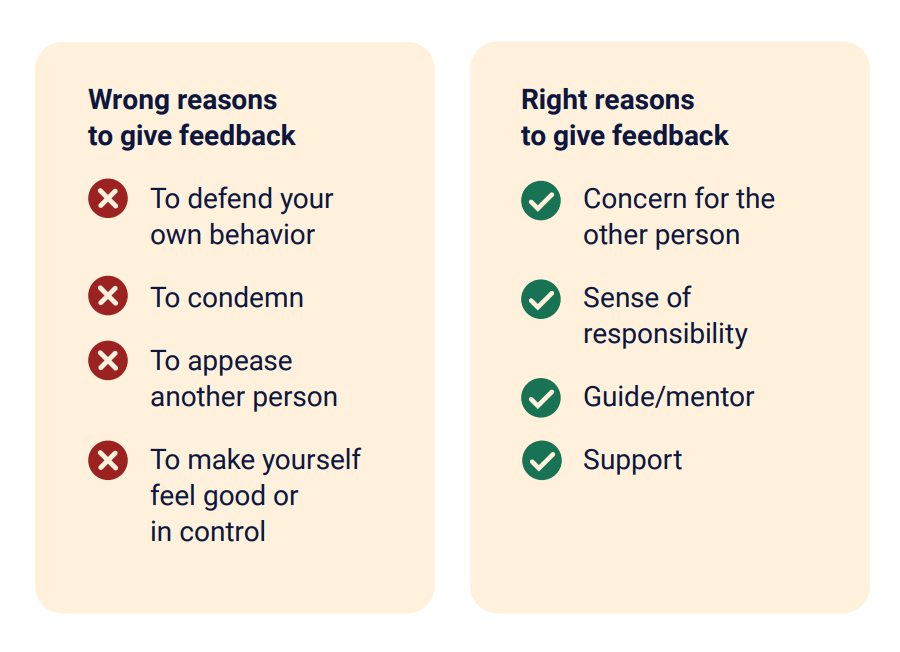
Providing effective employee feedback is a skill that develops with time and experience. Here are key points to keep in mind:
- Be specific and timely: Avoid vague generalizations. Focus on specific incidents and behaviors, providing clear examples to illustrate your points. Maintain a positive, supportive tone with a growth mindset, and deliver feedback promptly to allow for course correction.
- Address the incident, not the personality: Concentrate on the specific situation rather than making personal or emotional judgments. Avoid relying on rumors or secondhand information—stick to observable facts.
- Describe the situation constructively: Instead of launching into complaints, start with genuine appreciation and then describe the situation objectively. For example, rather than saying, "You’re creating a toxic environment," explain the behaviors observed and how they impact the team.
- Share your perspective and experiences: Frame feedback with empathy by sharing a personal story where you faced a similar challenge and how you overcame it. This approach fosters a conversational tone rather than making the feedback feel like criticism.
- Collaborate and offer actionable solutions: Use your experience to work together on solutions that help the employee address the challenge. This collaborative approach fosters a positive feedback culture and ensures the employee feels supported and valued.
FAQ

How does feedback improve employee performance and engagement?
When delivered effectively, feedback—whether positive or constructive—can significantly enhance employee performance and engagement. Here’s how:
- Clarifies Expectations: Feedback identifies key performance indicators and provides clear direction.
- Boosts Motivation: Constructive feedback motivates team members to achieve goals and objectives.
- Enhances Individual Performance: Personalized feedback helps employees refine their skills and improve their contributions.
- Fosters Engagement: Regular feedback encourages greater involvement at work and strengthens collaboration with peers.
How do you give feedback to remote employees?
It’s essential to be clear and specific when giving feedback to remote employees.
When you can’t meet in person, it’s harder to pick up on body language and tone.
Regular video calls can establish a connection with team members to make feedback conversations easier. Active listening in these calls will help you create a custom approach to feedback for each employee.
How does formal feedback differ from informal feedback?
Formal feedback involves regularly scheduled performance reviews and one-on-one meetings between a direct report and their manager.
Informal feedback includes checking in during the workday and complimenting someone during casual conversations.
Both forms of feedback are essential to creating a healthy workplace.
What is the first rule for providing feedback?
The first rule for providing feedback is don’t expect them to be mind readers. Choose your words carefully. You can be direct while still being polite.
Your feedback should always be clear. If your feedback is confusing, you’ve wasted your time and your employee’s time.
Oh, and we’re not sure where the “feedback sandwich” started, but leave the sandwiches in the lunch room.
Conclusion
As you can see, there are numerous benefits to giving feedback to your employees and encouraging them to provide feedback in return.
While implementing a successful employee feedback mechanism takes effort, you don’t have to do it alone.
Contact us today to schedule a demo and see how we can assist with the employee feedback process.